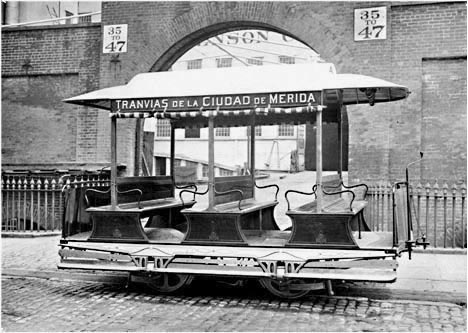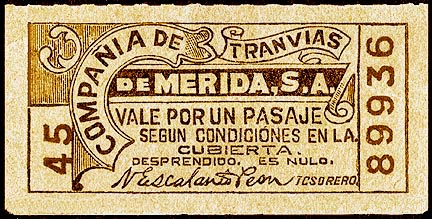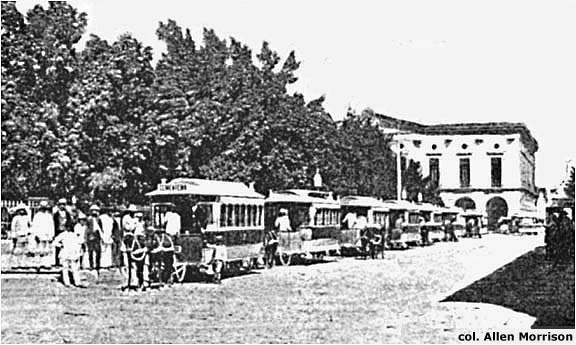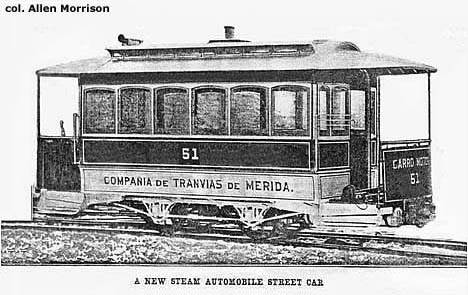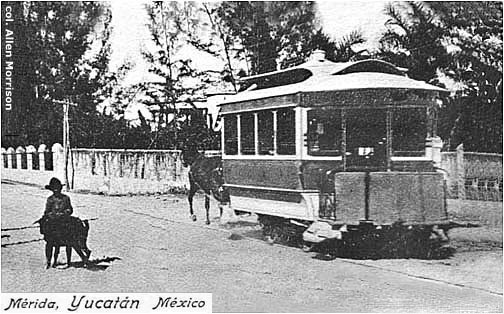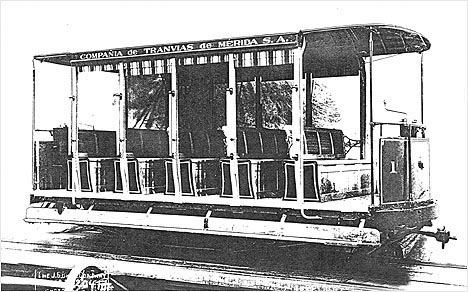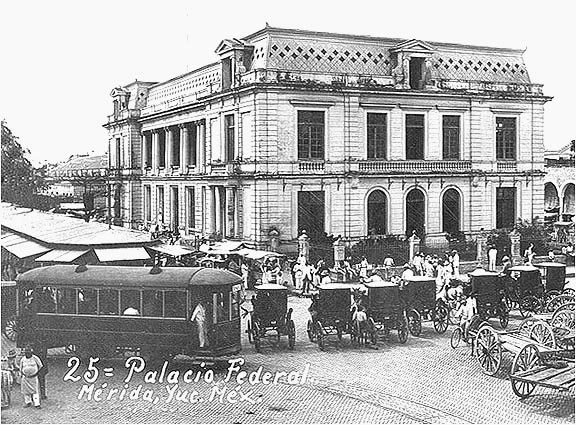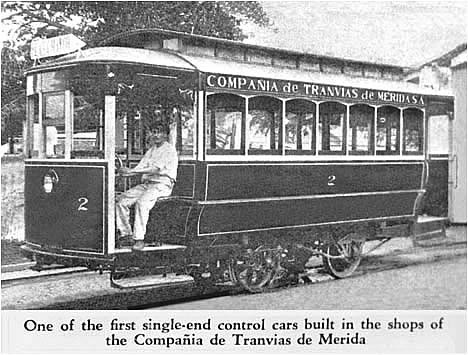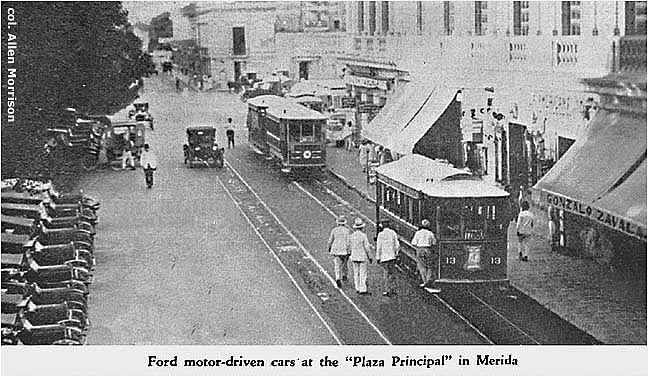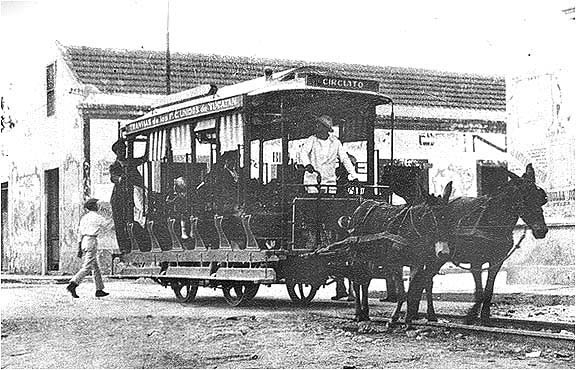The Tramways of BY
Go to Part 2: Intercity Lines Part 3: Plantation Railways Part 4: The Last 50 Years Part 5: Bibliography
Part 1: Introduction, Urban Lines
Introduction Yucatán state had approximately 4,500 km of tramway track [see map], more than all the other Mexican states combined. It was a colossal network, unequalled by any other in the world. Most of the lines were on plantations, or ran from the plantations to the railroad stations and towns. They were private at first, but many later became common carriers. There were also conventional passenger tramways between and within towns, including the capital, Mérida. The majority of Yucatán trams were horsedrawn. A few were powered by steam engines, storage batteries or gasoline motors. None drew electricity from overhead wire. Yucatán was the center of Mexico's henequen (sisal hemp) industry during the last half of the 19th and first half of the 20th centuries. Hundreds of plantations dotted the flat, rocky terrain and an elaborate network of railways was devised to transport the hemp from the fields to the ports for shipment abroad. The railways also transported workers and, later, the general public. Yucatán produced 90% of the world's twine in 1916 and became one of Mexico's richest states. International competition and the development of synthetic fibers decimated its economy in the 1920s and the figure dropped to 15% by 1935. Many of the plantations closed and the railways were abandoned. But they were not removed: some of the track remains and is still in use today. Government maps and surveys provide information about Yucatán's rail lines [see BIBLIOGRAPHY]. But there are not many photographs that show them in operation. These pages provide only a brief survey of the tramways of Yucatán.
Because of its remote location [far right on the map of Mexico in the Introduction], the development of railways in Yucatán was different from that in the rest of the nation. The first lines served the henequen industry and the population centers that grew up around it. Railway construction was rapid after 1880 and by 1900 Yucatán had more kilometers of track than any other state. But it had no rail connection with the rest of Mexico until 1950! Until that time, travel to Yucatán was primarily by ship from Veracruz. The date of the first rail line is uncertain. In Yucatán's Gilded Age [see BIBLIOGRAPHY], author Allen Wells states (p. 35) that Yucatán entrepreneur Eusebio Escalante imported the first Decauville tramway equipment in 1879. But he does not say when the equipment was put into use. Yucatán's first railway may have been the horsecar line that Escalante and his partner, Manuel Dondé, laid on the streets of the capital. It began carrying passengers on 15 September 1880. The builder of the first tram cars seems to have been the John Stephenson Co. in New York. The photograph below, taken about 1880, shows one of them at the Stephenson factory on East 27th Street in New York [John Stephenson Collection, Museum of the City of New York]:
Construction began in 1874 on Yucatán's first steam railroad, a 35 km 1435 mm gauge line from Mérida to Progreso [see Yucatán map], but it did not open until 1881. Another steam line opened east to Izamal in 1884 and the state's second tram system began operation in Progreso in 1893. Track gauge of both the Mérida and Progreso tram systems was 914 mm / 3 ft. A new organization, Compañía de Tranvías de Mérida, was founded on 18/6/1891 to take over and develop the city's tram lines. Here is one of its tickets (enlarged) [col. AM]:
Progress was rapid: the Anuario Estadístico [see BIBLIOGRAPHY] reported 25.4 km of tram track in Mérida in 1893 and 30.5 km in 1895. The gritty photograph below shows a lineup on Plaza de la Independencia in the mid-1890s. Most of these vehicles were probably built by John Stephenson in New York [Street Railway Review, Chicago, 10/1897, p. 685]:
Records of the J. G. Brill Co. in Philadelphia show several orders for Mérida in the late 1890s and early 1900s, but the Compañía de Tranvías continued to purchase vehicles from Stephenson. Here is a steam model built by Stephenson in 1902 at its new factory in Elizabeth, New Jersey. The boiler and pumps were on the platform next to the driver. The engine was between the axles under the car. Reeves Engine Co. of Trenton, New Jersey, supplied the equipment [Scientific American, New York, 24/1/1903, p. 57]:
The Anuario noted 34 km of track in 1900, 40 km in 1905, 46 km in 1906 and 50 km in 1907 [its last report]. An article in New York's Street Railway Journal of 5/1/1907 said that Mérida had 150 streetcars. It was Mexico's sixth-largest city in 1910. This postcard view from 1912 shows a Stephenson tram similar to the car above, but horsedrawn [col. AM]:
On 15/12/1917 Compañía de Tranvías ordered two cars from Brill, one open and one closed, that were powered by electric storage batteries. Here is open car 1. The batteries were in the compartments beneath the seats [Brill Collection, Historical Society of Pennsylvania]:
The undated postcard view below shows a self-propelled tram at the Post Office, which may be battery car number 2. Note horse taxis [col. Museo de los Ferrocarriles de Yucatán]:
Ferro-Carriles Unidos de Yucatán (United Railways of Yucatán), formed in 1902 to consolidate the state's long-distance steam lines, ordered three 8-wheel battery cars from Brill on 5 January 1918, but it is not known where or how they were used. Streetcars powered by steam engines and storage batteries were apparently unsatisfactory in Mérida for the Compañía de Tranvías ordered no more. In 1919 it began to equip its trams with gasoline motors. Here is car 2 of the new series [Electric Railway Journal, NY, 19/11/1927, p. 933]:
CTM eventually equipped 50 trams with gasoline motors for operation on its 12 routes. By the late 1920s the system had 53 km of track. Here are 3 cars downtown. Note the taxi lineup on the left [Electric Railway Journal, above]:
The project was so successful that CTM constructed and exported gasoline cars to other Mexican cities. But it was no use. The prosperous, growing metropolis was paving its streets and Mérida's trams could not compete with taxis and automobiles. The last urban tram ran in 1930. The gasoline-powered cars were sold to the interurban lines [see Part 2], where they ran for another 20 years. The tram depot, on Calle 66A between Calles 61 and 63 (3 blocks west of Plaza de la Independencia), was transformed into Hotel Las Monjas.
Urban Lines: Progreso The history of tramways in Yucatán's chief port, 35 km north of Mérida [see map], is mysterious. A local entrepreneur named José María Castro Lara secured a franchise in 1886 to build a street railway in Progreso. Brill records show orders for 4 cars in 1890 and a Stephenson ad of 1891 claims that Progreso was a customer (Stephenson records are lost). The line opened in 1893. The Anuario Estadístico [see BIBLIOGRAPHY] lists 3.113 km of narrow-gauge tramway track in Progreso in its 1893 through 1896 editions. It also shows a 10 km tramway from Progreso to Chicxulub [see map]. But neither operation is listed in the Anuario's next seven editions, from 1897 through 1903. Did they close? Or did they fail to report to the Anuario Estadístico? The Album Yucateco of 1901 [see BIBLIOGRAPHY] says that the Agencia Comercial operated 125 plataformas (flat cars) on 3.065 km of track along the docks in Progreso. The 1904 Anuario shows 2.5 km of 914 mm ferrocarril urbano. The 1905 edition notes 4 companies: Tranvías de Progreso 2.5 km, Agencia Comercial 2.612 km, Agencia Mercantil Marítima 2.039 km, and Echánove Hermanos 0.892 km - all using 914 mm gauge. The 1906 and 1907 editions both show 2.8 km of 930 mm track without further details. The Anuario did not publish tramway data after 1907. Ferro-Carriles Unidos de Yucatán, the steam railroad company [see above], ordered several 6-bench horsecars from Brill in 1904-5 and began operating a tramway in Progreso about that time. Did it take over an old line or build a new one? The photo below shows a Brill car numbered 6 with the inscription "Tranvías de los F. C. Unidos de Yucatán". It is not 100% certain that this photograph shows a tram in Progreso, but FCUY was the operator and one of its routes was a "Circuito" that circled the town [col. Museo de los Ferrocarriles de Yucatán]:
Tranvías de Progreso (F. C. Unidos de Yucatán?) ordered two 5-bench horsecars from Jackson & Sharp Co. in Wilmington, Delaware, in 1914. Here is an aerial view of Progreso that shows a highway stretching to the horizon - and to Mérida? Though small in this photograph, the tram looks like one of the battery or gasoline-powered models that also ran in the capital [postcard, col. AM]: |

The World Survey of Foreign Railways [see BIBLIOGRAPHY] reported 4 trams - 2 powered by animals and 2 by gasoline - running on 3.2 km of track in Progreso in 1933. The Yucatán government's Enciclopedia Yucatanense says that Ferro-Carriles Unidos de Yucatán operated 7 km of tram track in Progreso in 1936. It is not known when the Progreso tramway disappeared. It is not there today.
In addition to Mérida and Progreso, a 1908 survey by Rafael de Zayas Enríquez [see BIBLIOGRAPHY], found "ferrocarriles urbanos" in eight other cities : Halachó, Maxcanú, Chocholá, Timucuy, Acanceh, Homún, Tixkokob and Telchac [see map]. In all, Zayas counted 107 km of tram track in 10 towns that year. Other surveys published before and since that date found urban tramways also in Hunucmá, Motul and Hoctún. Most of these places are small. All were served by interurban tram lines [see Part 2]. The author feels that the latter provided a sort of local service in these towns and they did not really have tramway systems of their own. In any case, no other information and no pictures of any of them could be found.
Go to
return to Copyright © 2004-2104 Allen Morrison - ALL RIGHTS RESERVED |
